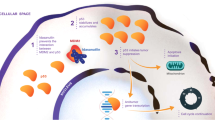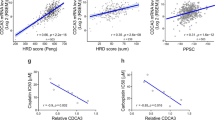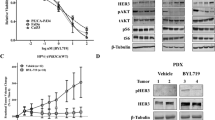Abstract
The hdm-2 oncogene is overexpressed in several types of malignancies including osteosarcomas, soft tissue sarcomas and gliomas and hdm-2 has been associated with accelerated tumor formation in both hereditary and sporadic cancers. Among the other key binding partners, hdm-2 forms a complex with the tumor suppressor p53, resulting in a rapid proteasome-mediated degradation of the p53 protein. This positions the hdm-2–p53 complex as an attractive target for the development of anticancer therapy and recently the first small molecule hdm-2 antagonist has been reported. Development of hdm-2 antagonists is currently focused on malignancies containing a wild-type p53 genotype, which is the case in approximately half of human cancer indications. However, hdm-2 has also been implicated in oncogenesis in the absence of p53. We therefore studied the effect of hdm-2 antagonists in p53-deficient human H1299 lung carcinoma cells. The hdm-2 antagonistic peptide caused G1 cell cycle arrest, inhibited colony growth and induced expression of G1 checkpoint regulatory proteins, such as p21waf1,cip1. These data demonstrate that hdm-2 regulates the G1 cell cycle checkpoint in a p53-independent manner, suggesting that hdm-2 antagonists represent a novel class of anticancer therapeutics with broad applicability towards tumors with different p53 genetic backgrounds.
This is a preview of subscription content, access via your institution
Access options
Subscribe to this journal
Receive 50 print issues and online access
$259.00 per year
only $5.18 per issue
Buy this article
- Purchase on Springer Link
- Instant access to full article PDF
Prices may be subject to local taxes which are calculated during checkout




Similar content being viewed by others
References
Blattner C, Sparks A, Lane D . (1999). Mol Cell Biol 19: 3704–3713.
Blaydes JP, Gire V, Rowson JM, Wynford-Thomas D . (1997). Oncogene 14: 1859–1868.
Bond GL, Hu WW, Bond EE, Robins H, Lutzker SG, Arva NC et al. (2004). Cell 119: 591–602.
Bottger A, Bottger V, Garcia-Echeverria C, Chene P, Hochkeppel HK, Sampson W et al. (1997a). J Mol Biol 269: 744–756.
Bottger A, Bottger V, Sparks A, Liu WL, Howard SF, Lane DP . (1997b). Curr Biol 7: 860–869.
Cordon-Cardo C, Latres E, Drobnjak M, Oliva MR, Pollack D, Woodruff JM et al. (1994). Cancer Res 54: 794–799.
Dobbelstein M, Wienzek S, Konig C, Roth J . (1999). Oncogene 18: 2101–2106.
Fakharzadeh SS, Rosenblumvos L, Murphy M, Hoffman EK, George DL . (1993). Genomics 15: 283–290.
Fischer PM, Lane DP . (2004). Trends Pharmacol Sci 25: 343–346.
Hollstein M, Sidransky D, Vogelstein B, Harris CC . (1991). Science 253: 49–53.
Jones SN, Hancock AR, Vogel H, Donehouwer LA, Bradley A . (1998). Proc Natl Acad Sci USA 95: 15608–15612.
Jost CA, Marin MC, Kaelin WG . (1997). Nature 389: 191–194.
Kussie PH, Gorina S, Marechal V, Elenbaas B, Moreau J, Levine AJ et al. (1996). Science 274: 948–953.
Lane DP . (1992). Nature 358: 15–16.
Lorens JB, Bennet MK, Pearsall DM, Throndset WR, Rossi AB, Armstrong R et al. (2000). Mol Ther 1: 438–447.
Martin K, Trouche D, Hagemeier C, Sorensen TS, Lathangue NB, Kouzarides T . (1995). Nature 375: 691–694.
Momand J, Zambetti GP . (1997). J Cell Biochem 64: 343–352.
Sdek P, Ying H, Chang DL, Qiu W, Zheng H, Touitou R et al. (2005). Mol Cell 20: 699–708.
Swift SE, Lorens JB, Achacoso P, Nolan GP . (1999) In Coligan RCJE, K. A. M. D. S. E. S. W. e. N. Y. W. (ed). Current Protocols in Immunology. Unit 10.28 Suppl 31.
Vassilev LT, Vu BT, Graves B, Carvajal D, Podlaski F, Filipovic Z et al. (2004). Science 303: 844–848.
Vindelov LL, Christensen IJ, Jensen G, Nissen N . (1983). Cytometry 3: 332–339.
Zhang Z, Wang H, Li M, Agrawal S, Chen XB, Zhang RW . (2004). J Biol Chem 279: 16000–16006.
Acknowledgements
We thank Lut Janssen and Kristin Mertens for technical assistance and support. Special acknowledgements to Najoua Dendouga for helpful discussions about this manuscript and associated work.
Author information
Authors and Affiliations
Corresponding author
Rights and permissions
About this article
Cite this article
VanderBorght, A., Valckx, A., Van Dun, J. et al. Effect of an hdm-2 antagonist peptide inhibitor on cell cycle progression in p53-deficient H1299 human lung carcinoma cells. Oncogene 25, 6672–6677 (2006). https://doi.org/10.1038/sj.onc.1209667
Received:
Revised:
Accepted:
Published:
Issue Date:
DOI: https://doi.org/10.1038/sj.onc.1209667
Keywords
This article is cited by
-
YBX1 mediates autophagy by targeting p110β and decreasing the sensitivity to cisplatin in NSCLC
Cell Death & Disease (2020)
-
Nutlin-3, an Antagonist of MDM2, Enhances the Radiosensitivity of Esophageal Squamous Cancer with Wild-Type p53
Pathology & Oncology Research (2018)
-
Molecular oncology of lung cancer
General Thoracic and Cardiovascular Surgery (2011)
-
Targeting the ubiquitin system in cancer therapy
Nature (2009)
-
MDM2 antagonist nutlin-3 is a potent inducer of apoptosis in pediatric acute lymphoblastic leukemia cells with wild-type p53 and overexpression of MDM2
Leukemia (2008)



